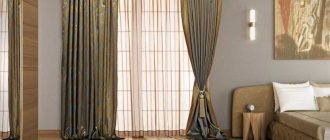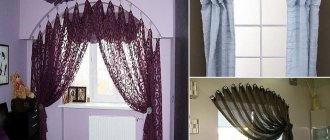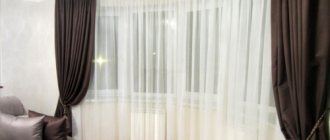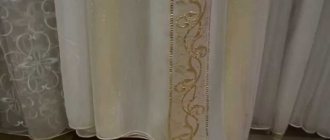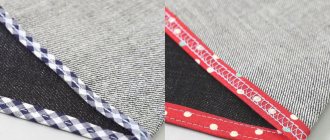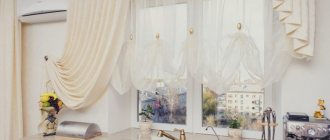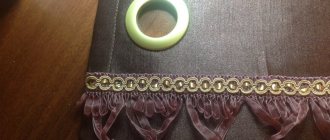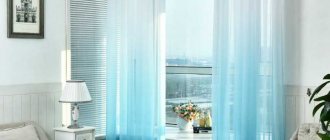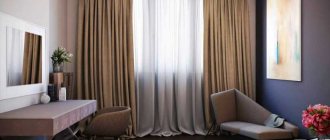A decorated window completes the image or sets the tone for the interior style of the room. Light and airy tulle plays an important role here, balancing even heavy curtains.
If you follow fashion, in Asia they prefer to close off rooms from prying eyes from the street, and in Europe they hang curtains without tulle.
Curtain rods for tulle
With the help of cornices, tulle is hung and secured, or decorated in a room. In the first case, molding is used to hide the cornice.
Cornices are divided into those attached to the ceiling - strings, and those attached to the walls - tubular. The profile and baguette are suitable for both the ceiling and the wall.
The classic ceiling cornice, on which curtains and curtains are hung regardless of size, is inexpensive. This cornice is a plastic single, double or triple niche, where hooks move along the guides.
The cornice is attached to the ceiling (also suitable for walls) with screws. The product is flexible and comes complete with fittings - corner pieces, plugs and other decor.
The cornice is a telescopic pipe. It is most often found in the bathroom, but is also suitable for insertion into a window opening. In this case, the tulle covers only the inner glass part of the window. This cornice is also suitable for bay windows.
The profile cornice is controlled by a remote control or a special light sensor. The cornice details are a durable aluminum profile that will hold a heavy fabric composition.
In a string cornice, tulle hangs on hooks that move along stretched strings. If desired, use a decorative strip to cover the strings. The fastening is not complicated, but the tighter the strings are, the greater the load on the fastening, which gradually weakens and pops out. Therefore, such a cornice is not suitable for heavy curtains.
Baguette cornices with tulle are often used to decorate rooms rather than to be used purely for practical purposes.
The trend is wooden, metal or plastic baguette cornice. This design has a wooden plank behind which the internal parts are hidden.
More: Electrical panel: where is the best place to install?
A common type of cornice is tubular. This is a wall-mounted cantilever structure with rings placed on a pipe with a diameter of 1-4 cm. The rings are equipped with special fastenings for curtains.
Which curtain rods are best to hang tulle on?
The choice of curtain rods is quite large, so it is difficult to choose a truly good option among such abundance. It is important to take your time with the choice and carefully think through every step, every little detail, decide how to hang the tulle (photo of the window design option below) most advantageously, and only after that buy a cornice.
All models are made from different materials, characterized by different sizes and finishing options. Cornices are:
- ceiling - the most budgetary and effective option;
- telescopic - used in the bathroom;
- profile - aluminum models capable of holding multilayer compositions;
- baguette - ideal for high rooms;
- rod - the most popular option.
How to attach tulle
Tulle fabrics are clamped with magnet clips and clothespins, hooked onto hooks, and strung onto a pipe with sewn eyelets, creating folds. These fasteners are mounted on rings that slide easily along the curtain rod, helping to easily move the curtain aside. Clothespins - butterflies, dragonflies, beetles and other brightly colored insects.
It is more difficult to move tulle with textile loops made of ribbons or braid. Velcro and bow ties look original, which are also difficult to move, like a curtain with a drawstring. The advantage of a stitched drawstring is that it is easy to put on the cornice and arrange in equal folds.
Tip: wooden parts are selected for natural materials, and metal parts for synthetic ones.
Without a cornice, tulle is hung on a decorative cord, which is threaded through rings attached to the wall. Treated and varnished tree branches are suitable. Some are attached to hooks on the wall or with a staple gun. With these methods, the curtain can no longer be pulled back.
Popular trends in window decoration with tulle
For many centuries, the classics have not left their leadership positions. Even the most inconspicuous and plain fabric will look great if you choose the right fittings and fasteners and know exactly how to beautifully hang tulle in a particular room. For rooms with a bright interior, tulle with photo printing will be a real find. The most interesting thing is that you can choose the design at your discretion and desire.
Tulle also goes well with a variety of curtains. The main thing is that they fit each other perfectly in shape and color.
Decorating a light curtain
Using decorative elements it is not difficult to turn a tulle curtain into a room decoration:
- grabs and clamps;
- decorative cords;
- satin and nylon ribbons;
- lace, artificial flowers, bows or beaded threads are sewn to the loops;
- Glue multi-colored pebbles and beads to hairpins and magnets and create patterns;
- decorate with fringe;
- tie up the curtain with chains, ribbons with tassels and pom-poms, or a leather belt.
How to combine curtains and drapes
Thanks to its airiness, tulle fits perfectly into the interior either as a single window decoration or in combination with curtains. In addition, the most effective combination of such weightless light fabric is obtained with dense and rather heavy material. Typically, contrasting colors are chosen; as a rule, tulle curtains often have lighter tones, and drapes have dark and bright saturated shades.
Fashion trends
There are no special innovations in window decoration today as such, but there are still a number of well-established fashion trends.
The classics also remain relevant. To decorate in a classic style, you can use roller blinds in combination with tulle. It can be plain or with a small pattern. Roller blinds can also be made of a plain fabric or have a pattern. This type of design also includes Roman blinds.
Roman curtains
The classic style also involves the use of denser fabrics, both the curtains themselves and tulle. At the same time, it is recommended to decorate them with lambrequins or assemble them using a cord or a clip.
Advice! If expensive material was used for the curtains, then for tulle it is better to take a simpler and lighter fabric.
When decorating windows in a country house, the country style is becoming increasingly popular, where only natural and environmentally friendly materials are supposed to be used. For example, for curtains you can choose linen, satin, calico, but for tulle it is better to choose thin chintz fabric.
You might be interested in the materials from which tulle is made: what fabrics are used
In apartments, they try to design window openings more modestly, so they often choose a minimalist style, where it is preferable to use decorations and decor to a minimum.
Fabric for curtains in a minimalist style should be chosen light, with a calm, inconspicuous color and without a pattern. Light curtains are best complemented with the same light tulle fabric.
Window decoration in minimalist style
The art of drapery
Drapery - one-sided, counter or bow folds on the curtain. Few folds are made on thick tulle, and thin fabric is draped with frequent and narrow folds, and work done by hand lasts longer.
Using tiebacks, staples, rings, and sometimes thread, horizontal and vertical draperies of bizarre shapes are created.
Tip: when planning drapery, you will need to take fabric 1.5-3 times wider than the length of the cornice and purchase a special ribbon with loops in 2-3 rows.
To drape the bottom of a light curtain, the edge is raised in 1-3 places to the desired height and fastened to the canvas.
To create a classic wave, 1-2 sags are formed on the inner edge of the curtain.
MORE: What is an orthopedic mattress and what are its advantages?
If you intercept the middle of the curtain or the top and bottom, you will get an elegant “column” or “vase”.
By draping in one-way folds, the vertical waves of the fabric are laid to one side.
To create counter folds, every two folds face each other.
Bow folds are formed by folding two folds inward from the outer sides.
Distributing the fabric in uniform vertical ridges, the curtain is decorated with pencil folds.
Complex Flemish folds. A braid with two rows of loops is taken and the upper and lower threads are simultaneously pulled together, creating a knot similar to a V. The bottom of the resulting fold is strongly pulled together, maintaining the expressiveness of the upper gather.
The weighted bottom of the curtains will help maintain drapery.
For this use:
- weight tape;
- embroidery at the bottom of the curtain with rhinestones, threads, sequins or beads;
- lace inserts.
Calculation of tulle length after choosing cornice and fittings
When answering the question of how the tulle should hang, you should first correctly calculate the required length of the fabric, taking into account the type of cornice chosen and the corresponding fittings.
Typically, the length of the tulle is taken with the expectation that 1-2 cm is required from the floor or ceiling. A more practical fit would be to hang the tulle 10-15 cm from the floor (window sill). The calculation is performed by measuring the distance from the cornice to the floor, taking into account the allowance for the hem at the bottom and for fixing the tape at the top.
The choice of cornice directly depends on the style direction of the interior. For the kitchen, you should use the most practical type, such as a rod or ceiling cornice.
As for accessories, they can be divided into 2 main categories:
- fastening elements (clips, rings, loops, hooks);
- decorative (braid, cords, fringe).
Tulle hooks
How to hang tulle in an original way
A novelty in modern interiors is a light-transmitting curtain without thick curtains, but in the same palette as the walls or in white. Options: multi-layering, vagas, patterns, lambrequins, tulle with inserts and metallized fragments.
Tip: lambrequins are not suitable for small rooms below 2.5 m, because the ceiling will visually lower.
Multi-tiered
They use fabrics of different textures, but with shades of the same tone.
Intersecting Layers
Take 2-3 colors of plain tulle (other textures will do) and create waves of weaves.
Suitable combinations:
- light delicate light green and pink color;
- blue with yellow;
- brown tint with orange color;
- options for blue and white shades;
- turquoise and beige color.
The main requirement in using a color combination is harmony with the color and purpose of the room.
Examples:
- Natural shades - beige, gray, peach or brown on one layer with white tulle on the other layer
- Layers of fabrics in contrasting shades: pink and gray tulle, yellow and purple, red and coffee tulle.
- A plain veil or organza and a dense, patterned or embroidered fabric for it.
- In the “northern” room there is a white and orange option.
Bright, cheerful, but not flashy curtains are hung in the nursery. Tulle of a calm color is appropriate in the bedroom.
Original asymmetry for non-standard windows
It assumes a long vertical drapery on one side, and a shortened one on the other side of the window, or one panel is wider than the other. The bottom edge cut in the form of an arch, diagonally or in a wave looks interesting. There is a pickup on one side, but not on the other.
More: Benefits of an artificial Christmas tree
Tip: asymmetry is not suitable for a minimalist and high-tech style.
Features of tulle products
Before hanging tulle on the cornice, you need to take into account the characteristics of the room. If we talk about the kitchen, then lambrequins and various waves will be inappropriate in it. Experts also recommend using light tulle in small rooms. It will visually expand the space and make the room brighter. Very often there is a balcony door in the bedroom, so it is necessary to ensure that the tulle does not impede access to it.
Each room in the house is a separate space that you need to be able to decorate correctly and harmoniously:
- Bedroom. Very often, massive, multi-layered compositions are selected for the bedroom. These compositions are fixed to the ceiling and baguette cornice. You can simply drape the tulle using curtain tape.
- Kitchen. Since there is high humidity in the kitchen, soot and grease constantly settle on the surface, it is best to choose a short tulle that reaches the window sill. It is better to choose a rod or telescopic cornice, and fabric loops will do just fine for fittings.
- Hall. To decorate a living room, tulle in pastel shades and fittings made in the same colors are perfect. It is important that the fittings are not too provocative, but are fully consistent with the chosen style.
Design tips
Despite the fact that hanging tulle on a cornice is not difficult, some designers still offer some tips on how to beautifully assemble a tulle composition for a window, for example, the necessary drapery and the shape of the curtains.
How to create the necessary drapery and curtain shape
Tulle draping can be done in 2 ways:
- fixed;
- using accessories.
Fixed drapery should be done at the stage of sewing the curtain using a special curtain braid, which is glued or sewn on the wrong side of the fabric. They create drapery by pulling out the adjustable laces with which it is equipped after sewing the curtain tape.
Creating drapery using accessories: using staples or tiebacks, this allows you to adjust the number of folds and change the shape of the curtains at any time.
Draping curtains
How to create folds
Before draping the tulle, you should first decide what type of folds you want to make.
There are mainly 3 types of basic folds:
- one-sided, where the tulle is laid in one direction;
- counter, where they are laid so that the folds are folded towards each other;
- bow ones, where paired folds are laid so that their folds are located in opposite directions (the wrong side of the opposing folds).
Tulle today has considerable popularity, not only because this fabric is light and airy, but also because of the possibility of creating an original and unique window decoration. Light and elegant tulle can fit perfectly into the interior either as a single design or in combination with curtains.
How to beautifully assemble curtains on a ribbon with a photo
The most common type of decorative assembly is the accordion. It is easy to form on any type of fabric - from light and transparent to dense, but with good drape ability. It is enough to use a curtain tape with a coefficient of 2.5 to get on a string or a narrow crossbar the desired picturesque gathering, reminiscent of the bellows of a musical instrument.
Pencil folds are also used quite often, but they use curtain tape with a different gathering factor (2.5).
A relatively simple option, one-sided folds, are used by people who are inclined to maintain constant order, perfectionism and symmetry. There is a similar option when the folds on the curtains are directed from opposite walls towards each other.
This is also a simple option, for which you just need to correctly sew the curtain tape of the required coefficient. French pleats and butterflies, which look like pompous diamonds, require the purchase of a special curtain tape with four rows and some skills as a seamstress and draper. So, if they are not there, you will have to seek services from a special workshop.
Types of curtain tapes
Curtain tape is a fabric strip that is sewn to the back of products. The width of the material is conveniently adjusted with cords located in the ribbons.
Thanks to the braid, you can create a chic drapery for any fabric. This eliminates the need to sew additional loops for such hooks. The threads on the sides are sewn together as quickly as possible, the total sewing time is reduced several times.
There are several types of curtain tapes that are used in practice by designers:
- When using adhesive tape with loops everything is secured to the cornice.
- If you use hot irons for gluing.
- Involving the use of sewing machines.
- With assembly coefficients from 1.5 to 3. The number determines how many folds there will be on the product.
- When there are a lot of draw-out pockets for hooks, or vice versa.
- With the formation of bows.
- With tucks.
- Wide up to 15 centimeters.
- Narrow.
The following elements are often included with curtain tape:
- Cords for tie.
- Fastening with hooks and pockets.
- Sealing elements.
- Ring parts for eyelets.
The size of the folds determines the length of products such as tulle on curtain tape.
How to assemble tulle on a ribbon 2 rows beautifully and quickly
Many tips and tricks that are recommended for heavy or well-draped fabrics are not applicable in the case of light, often synthetic fabrics. It is not recommended to make extra holes on such fabrics even with thin sewing needles, so curtain tape is usually chosen from nylon, in a lightweight version.
The step-by-step instructions in this case are quite simple:
- the purchased fabric must be washed in warm water and dried to determine the degree of possible deformation;
- then it is aligned along the edge, achieving maximum correspondence between the longer and shorter sides, folding them in pairs;
- the edges of the cuts are carefully processed with an overlocker or hemmed from below, if necessary;
- the edge of a thin fabric can crumble, so the edge of the top edge is also overlocked;
- in the upper part, measure a bend slightly larger than the width of the braid, after which it is ironed dry;
- The braid is sewn on by machine along two edges, after which a tie of folds is formed simultaneously on both sides.
For reference!
This method is useful for any cornice, string, and even simple hanging on a special mount installed on the wall. For an additional decorative effect, you can use any other devices - leather belts, textile insects and butterflies, buttons or crocheted elements.
Techniques and features of balayage hair coloring
